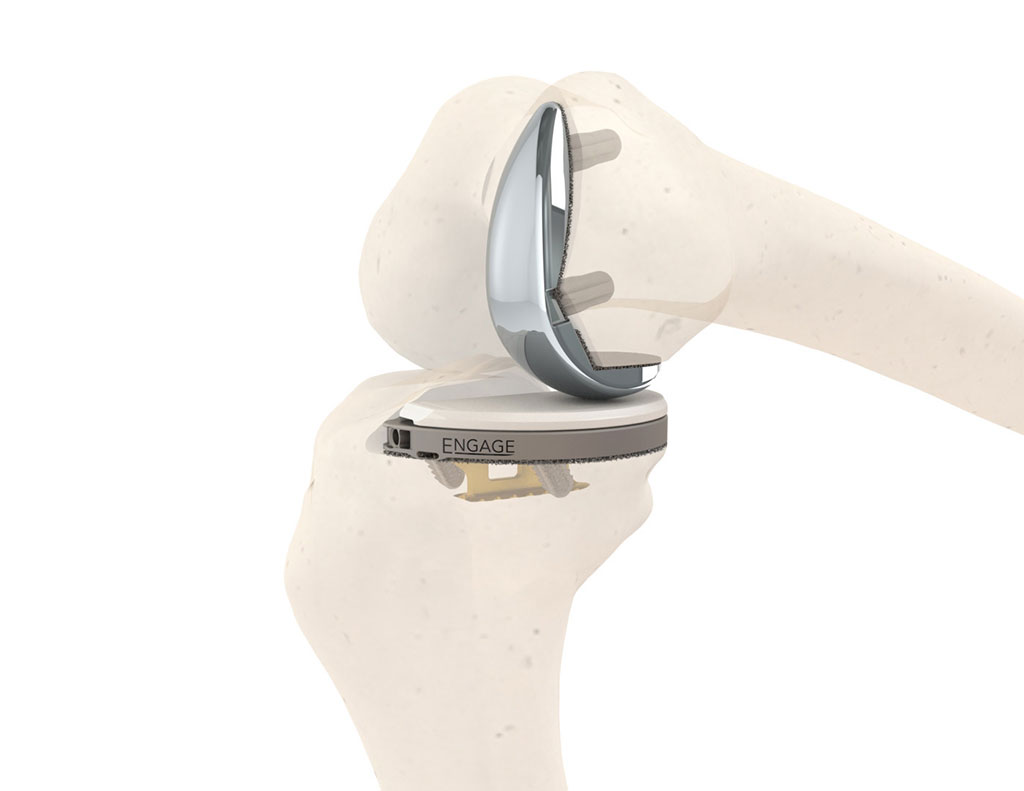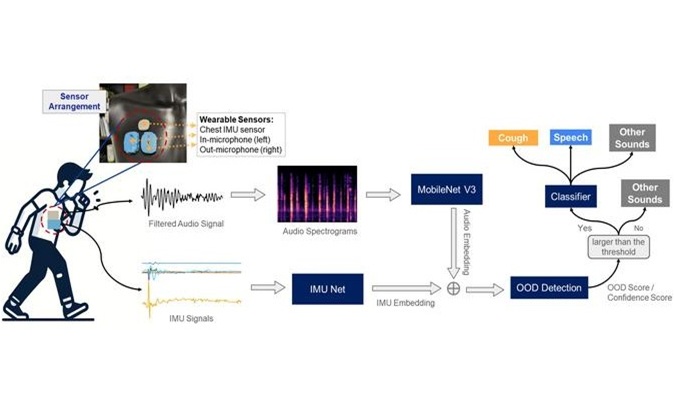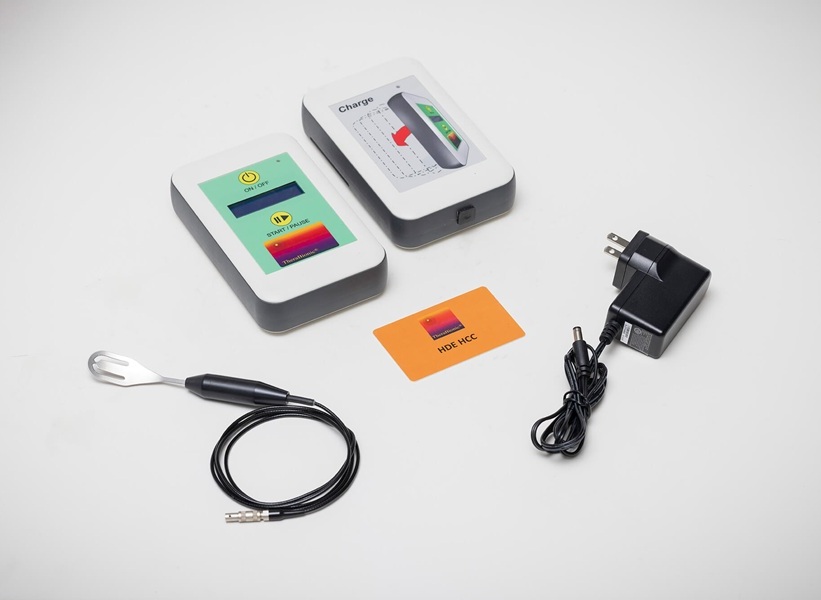Cementless Knee System Promotes Biological Fixation
|
By HospiMedica International staff writers Posted on 15 Jul 2020 |

Image: The cementless Engage partial knee system (Photo courtesy of Engage)
An innovative partial knee system (PKS) offers porous implants that encourage biological fixation on both the tibia and femur.
The Engage (Orlando, FL, USA) Cementless Engage PKS is optimized for the treatment of medial compartment arthritis. The Tibial Tray is additively manufactured with a titanium Affinium 3D ultra-porous bone ingrowth surface, which promotes long-term cementless fixation. The system features a reproducible ligament-guided surgical technique that is inspired by robotic methods. However, by using precise manual instruments, accurate implant placement and desired ligament balance can be achieved without the added setup time and extra expense associated with robotic and navigation techniques.
“We asked knee surgeons what problems we could help solve. A stable, non-cemented, ligament preserving, fixed bearing partial knee system was needed. Repeatedly, surgeons mentioned that active patients are more satisfied with their knee function when healthy articular cartilage and ligament balance is preserved,” said Dan Justin, CEO and co-founder of Engage. “To solve this problem, we brought together an experienced team of surgeons, engineers, and manufacturers who are proud to introduce this groundbreaking system.”
“The intuitive design of the instruments make this the best-in-class ligament-guided technique for partial knee replacement,” said Andrew Pearle, MD, chief of sports medicine at the Hospital for Special Surgery (HSS, New York, NY, USA). “Coupling this technique with a cementless design is a game changer, particularly for my younger, more active patients. The efficiency of the Engage implant system is ideal for use in the ambulatory surgery center setting. I am excited to use this system in my partial knee arthroplasty patients and returning them to their athletic activities.”
Partial (unicompartmental)l knee replacement involves placing an implant on just one side of the knee, rather than over the entire surface of the knee joint, as in a total knee replacement (TKR). Because the incision is smaller, patients have less pain, spend less recovery time in the hospital, and can be active sooner. The procedure also reduces risks of infection or blood loss. Patients treated with partial knee replacement have more functionality and greater range of motion than patients treated with a TKR.
Related Links:
Engage
Hospital for Special Surgery
The Engage (Orlando, FL, USA) Cementless Engage PKS is optimized for the treatment of medial compartment arthritis. The Tibial Tray is additively manufactured with a titanium Affinium 3D ultra-porous bone ingrowth surface, which promotes long-term cementless fixation. The system features a reproducible ligament-guided surgical technique that is inspired by robotic methods. However, by using precise manual instruments, accurate implant placement and desired ligament balance can be achieved without the added setup time and extra expense associated with robotic and navigation techniques.
“We asked knee surgeons what problems we could help solve. A stable, non-cemented, ligament preserving, fixed bearing partial knee system was needed. Repeatedly, surgeons mentioned that active patients are more satisfied with their knee function when healthy articular cartilage and ligament balance is preserved,” said Dan Justin, CEO and co-founder of Engage. “To solve this problem, we brought together an experienced team of surgeons, engineers, and manufacturers who are proud to introduce this groundbreaking system.”
“The intuitive design of the instruments make this the best-in-class ligament-guided technique for partial knee replacement,” said Andrew Pearle, MD, chief of sports medicine at the Hospital for Special Surgery (HSS, New York, NY, USA). “Coupling this technique with a cementless design is a game changer, particularly for my younger, more active patients. The efficiency of the Engage implant system is ideal for use in the ambulatory surgery center setting. I am excited to use this system in my partial knee arthroplasty patients and returning them to their athletic activities.”
Partial (unicompartmental)l knee replacement involves placing an implant on just one side of the knee, rather than over the entire surface of the knee joint, as in a total knee replacement (TKR). Because the incision is smaller, patients have less pain, spend less recovery time in the hospital, and can be active sooner. The procedure also reduces risks of infection or blood loss. Patients treated with partial knee replacement have more functionality and greater range of motion than patients treated with a TKR.
Related Links:
Engage
Hospital for Special Surgery
Latest Surgical Techniques News
- Novel Glue Prevents Complications After Breast Cancer Surgery
- Breakthrough Brain Implant Enables Safer and More Precise Drug Delivery
- Bioadhesive Sponge Stops Uncontrolled Internal Bleeding During Surgery
- Revolutionary Nano Bone Material to Accelerate Surgery and Healing
- Superior Orthopedic Implants Combat Infections and Quicken Healing After Surgery
- Laser-Based Technique Eliminates Pancreatic Tumors While Protecting Healthy Tissue
- Surgical Treatment of Severe Carotid Artery Stenosis Benefits Blood-Brain Barrier
- Revolutionary Reusable Duodenoscope Introduces 68-Minute Sterilization
- World's First Transcatheter Smart Implant Monitors and Treats Congestion in Heart Failure
- Hybrid Endoscope Marks Breakthrough in Surgical Visualization
- Robot-Assisted Bronchoscope Diagnoses Tiniest and Hardest to Reach Lung Tumors
- Diamond-Titanium Device Paves Way for Smart Implants that Warn of Disease Progression
- 3D Printable Bio-Active Glass Could Serve as Bone Replacement Material
- Spider-Inspired Magnetic Soft Robots to Perform Minimally Invasive GI Tract Procedures
- Micro Imaging Device Paired with Endoscope Spots Cancers at Earlier Stage
- AI Spine Model Could Reduce Surgical Risks
Channels
Critical Care
view channel
Origami Robots to Deliver Medicine Less Invasively and More Effectively
Delivering medicine to ulcers or other internal sites often requires invasive procedures that can disrupt surrounding tissues and lengthen recovery times. Traditional magnetic actuators used in soft robotics... Read more
Improved Cough-Detection Technology Aids Health Monitoring
Coughing serves as an important biomarker for tracking a variety of conditions and can help monitor the progress of respiratory diseases or predict when someone’s asthma is being exacerbated.... Read morePatient Care
view channel
Revolutionary Automatic IV-Line Flushing Device to Enhance Infusion Care
More than 80% of in-hospital patients receive intravenous (IV) therapy. Every dose of IV medicine delivered in a small volume (<250 mL) infusion bag should be followed by subsequent flushing to ensure... Read more
VR Training Tool Combats Contamination of Portable Medical Equipment
Healthcare-associated infections (HAIs) impact one in every 31 patients, cause nearly 100,000 deaths each year, and cost USD 28.4 billion in direct medical expenses. Notably, up to 75% of these infections... Read more
Portable Biosensor Platform to Reduce Hospital-Acquired Infections
Approximately 4 million patients in the European Union acquire healthcare-associated infections (HAIs) or nosocomial infections each year, with around 37,000 deaths directly resulting from these infections,... Read moreFirst-Of-Its-Kind Portable Germicidal Light Technology Disinfects High-Touch Clinical Surfaces in Seconds
Reducing healthcare-acquired infections (HAIs) remains a pressing issue within global healthcare systems. In the United States alone, 1.7 million patients contract HAIs annually, leading to approximately... Read moreHealth IT
view channel
Printable Molecule-Selective Nanoparticles Enable Mass Production of Wearable Biosensors
The future of medicine is likely to focus on the personalization of healthcare—understanding exactly what an individual requires and delivering the appropriate combination of nutrients, metabolites, and... Read moreBusiness
view channel
Philips and Masimo Partner to Advance Patient Monitoring Measurement Technologies
Royal Philips (Amsterdam, Netherlands) and Masimo (Irvine, California, USA) have renewed their multi-year strategic collaboration, combining Philips’ expertise in patient monitoring with Masimo’s noninvasive... Read more
B. Braun Acquires Digital Microsurgery Company True Digital Surgery
The high-end microsurgery market in neurosurgery, spine, and ENT is undergoing a significant transformation. Traditional analog microscopes are giving way to digital exoscopes, which provide improved visualization,... Read more
CMEF 2025 to Promote Holistic and High-Quality Development of Medical and Health Industry
The 92nd China International Medical Equipment Fair (CMEF 2025) Autumn Exhibition is scheduled to be held from September 26 to 29 at the China Import and Export Fair Complex (Canton Fair Complex) in Guangzhou.... Read more














